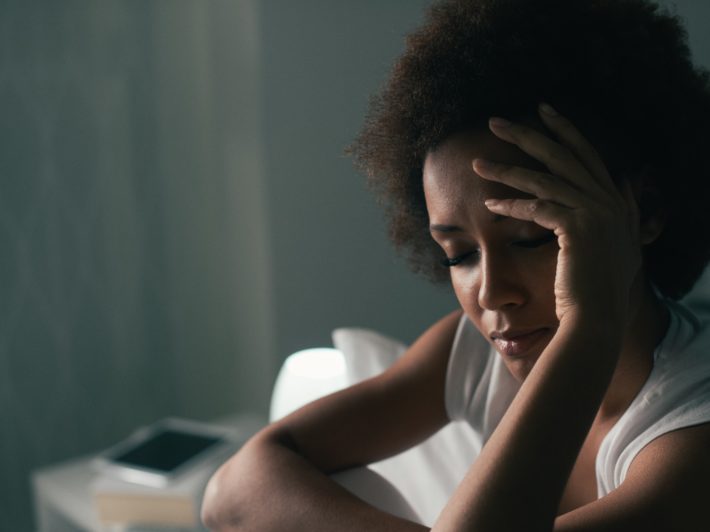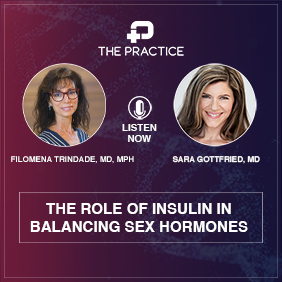
by Sara Gottfried, MD
Behind closed doors, women bear all. Overwhelming fear, feelings of worry, irritability, and tension may plague them, yet the conversation around their anxiety has remained mostly unchanged for the past thirty years in mainstream medicine. Although anxiety is our nation’s most common mental disorder, there are lingering feelings of shame surrounding the condition. Women, who often feel pressured to live up to unrealistic expectations, may suffer silently and refrain from seeking the help they deserve.
Anxiety at any stage of life
During her lifetime, a woman has a 31 percent chance of developing anxiety, which is higher than her male counterpart.1 This anxiety can appear in many ways. Following menarche, girls and young women may experience fear and worry in ways they never had before. Later, women of child-bearing age experience premenstrual anxiety and feel unable to find relief. Postpartum anxiety is also common and often overlooked. And later in life, women in their thirties may feel overwhelmed and unhappy, while women in their forties may feel anxious for the first time alongside perimenopausal and menopausal symptoms. Whatever the case, these women suffer from symptoms of anxiety and aren’t feeling empowered to talk about it.
The connection between anxiety and hormones
Changes in hormones, such as estrogen, progesterone, cortisol, thyroid, and oxytocin, make symptoms of anxiety worse. Clinical research has determined a link between a woman’s hormonal changes throughout life and the diagnoses of anxiety in the following ways:
- Menarche is associated with an increase in anxiety disorders.2
- Data on estrogen and anxiety are mixed, most likely because of differential effects of specific estrogen receptors—i.e., ER-alpha is anxiogenic, ER-beta is anxiolytic, and the newly discovered G-protein-coupled receptor-30 (GPR30) is both.3
- Many women experience increased anxiety before their periods, as estrogen and progesterone levels are declining. Often women with premenstrual syndrome (PMS) describe anxiety.4,5
- Early bilateral oophorectomy (removal of the ovaries) and resulting surgical menopause increase the risk of anxiety.6
- Menopause increases anxiety.7
Anxiety in a new light
Anxiety is not a choice or a moral failing. It’s clear that anxiety in women is connected to physiological changes throughout the life cycle. Still, women are shamed in many ways, but clinicians can do their part to help remove the shame and stigma from anxiety. No woman is alone in her experience with anxiety and should never be made to feel guilty about her anxious feelings.
Asking a woman to explore her own unique biology empowers her to look within and search for the why behind her anxiety. Although anxiety was previously seen as a mental condition, we now understand it through the lens of functional medicine. Most recently, a link between anxiety and the gut-brain axis has been established.8 In fact, a woman’s anxiety has commonly been found to stem from gut-brain dysfunction, which can lead to increased inflammation in the body followed by inflammation in the brain.
Questions to ask
When identifying anxiety in your patients, there are many telling questions to ask. The following come from the trusted Hamilton Anxiety Rating Scale.9
- How often do you feel anxious (i.e., worried, anticipating the worst possible outcome, irritable)?
- How often do you feel tense (i.e., easily startled, on the verge of tears, shakiness and restlessness, inability to relax)?
- How would you describe your fears (e.g., darkness, being alone, large crowds)?
- Do you ever find it hard to concentrate or stay focused?
- Do you tend to forget things easily?
- Do you ever experience aches and pains, twitching, teeth grinding, or a shaky voice? If so, how often?
- Do you ever feel overcome by a depressive mood (e.g., loss of interest and pleasure in things you usually enjoy)? If so, how often?
- How often do you experience gastrointestinal symptoms such as abdominal pain, burning sensations, fullness and bloating, nausea, loose bowels, or constipation?
- Do you experience any somatic symptoms, such as tinnitus, blurry vision, hot or cold flushes, faintness, or a prickling sensation?
- Have you noticed any cardiovascular concerns, such as tachycardia (rapid heartbeat), palpitations, chest pain, or faintness?
Changing the conversation
Look for signs of anxiety in your patients even when they don’t call attention to it or complain about anxious symptoms. When they do voice their concerns, reassure them and support them. Owning your own anxiety and showing empathy may help women feel more comfortable sharing their stories and symptoms. Further, encourage them to talk about their anxiety with friends and family and to write down their feelings in a journal to help track their progress. As they acknowledge their feelings and open themselves to solutions, you can begin to help them take the necessary steps toward relief.
Every woman has a unique story no matter what her stage of life, and no woman should feel ashamed to talk about her anxieties. By starting the conversation with patients who may be affected, you can help these women face their fears, make sense of their anxiety, and find the relief they deserve.
Learn more about treatments that are proven to help women deal with anxious feelings in part two of this series. Stay tuned!
References
- McLean CP, Asnaani A, Litz BT, Hofmann SG. Gender Differences in Anxiety Disorders: Prevalence, Course of Illness, Comorbidity and Burden of Illness. Journal of Psychiatric Research. 2011;45(8):1027-1035.
- Patton GC, Hibbert ME, Carlin J, et al. Menarche and the onset of depression and anxiety in Victoria, Australia. J Epidemiol Community Health. 1996;50(6):661-666.
- Borrow AP, Handa RJ. Estrogen Receptors Modulation of Anxiety-Like Behavior. Vitam Horm. 2016;103:27-52.
- Cameron OG, Kuttesch D, McPhee K, Curtis GC. Menstrual fluctuation in the symptoms of panic anxiety. J Affect Disord. 1988;15(2):169-174.
- Yonkers KA, O’Brien PM, Eriksson E. Premenstrual syndrome. Lancet. 2008;371(9619):1200-1210.
- Rocca WA, Grossardt BR, Geda YE, et al. Long-term risk of depressive and anxiety symptoms after early bilateral oophorectomy. Menopause. 2008;15(6):1050-1059.
- Sahingoz M, Uguz F, Gezginc K. Prevalence and related factors of mood and anxiety disorders in a clinical sample of postmenopausal women. Perspect Psychiatr Care. 2011;47(4):213-219.
- Clapp M, Aurora N, Herrera L, Bhatia M, Wilen E, Wakefield S. Gut microbiota’s effect on mental health: The gut-brain axis. Clin Pract. 2017;7(4):987.
- Adapted from: Hamilton M. The assessment of anxiety states by rating. Br J Med Psychol. 1959;32:50-55. https://dcf.psychiatry.ufl.edu/files/2011/05/HAMILTON-ANXIETY.pdf
Sara Gottfried, MD is a board-certified gynecologist and physician scientist. She graduated from Harvard Medical School and the Massachusetts Institute of Technology and completed residency at the University of California at San Francisco. Over the past two decades, Dr. Gottfried has seen more than 25,000 patients and specializes in identifying the underlying cause of her patients’ conditions to achieve true and lasting health transformations, not just symptom management.
Dr. Gottfried is a global keynote speaker who practices evidence-based integrative, precision, and Functional Medicine. She recently published a new book, Brain Body Diet and has also authored three New York Times bestselling books: The Hormone Cure, The Hormone Reset Diet, and Younger.






